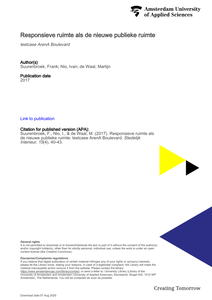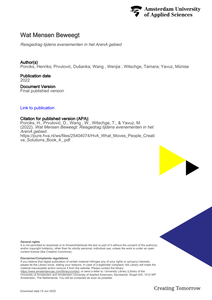Het urban technology onderzoeksprogramma van de hogeschool van Amsterdam (HvA) doet onderzoek voor de omschakeling naar een circulaire stad. Een van de factoren die hierbij een rol spelen is hoe producten circulair ontworpen kunnen worden.
DOCUMENT
The Johan Cruijff ArenA (JC ArenA) is a big events location in Amsterdam, where national and international football matches, concerts and music festivals take place for up to 68,000 visitors. The JC ArenA is already one of the most sustainable, multi-functional stadia in the world and is realizing even more inspiring smart energy solutions for the venue, it’s visitors and neighbourhood. The JC ArenA presents a complex testbed for innovative energy services, with a consumption of electricity comparable to a district of 2700 households. Thanks to the 1 MWp solar installation on the roof of the venue, the JC ArenA already produces around 8% of the electricity it needs, the rest is by certified regional wind energy.Within the Seev4-City project the JC ArenA has invested in a 3 MW/2.8 MWh battery energy storage system, 14 EV charging stations and one V2G charging unit. The plan was to construct the 2.8 MWh battery with 148 2nd life electric car batteries, but at the moment of realisation there were not enough 2nd life EV batteries available, so 40% is 2nd life. The JC ArenA experienced compatibility issues installing a mix of new and second-life batteries. Balancing the second-life batteries with the new batteries proved far more difficult than expected because an older battery is acting different compared to new batteries.The EV-based battery energy storage system is unique in that it combines for the first time several applications and services in parallel. Main use is for grid services like Frequency Containment Reserve, along with peak shaving, back-up services, V2G support and optimization of PV integration. By integrating the solar panels, the energy storage system and the (bi-directional) EV chargers electric vehicles can power events and be charged with clean energy through the JC ArenA’s Energy Services. These and other experiences and results can serve as a development model for other stadiums worldwide and for use of 2nd life EV batteries.The results of the Seev4-City project are also given in three Key Performance Indicators (KPI): reduction of CO2-emission, increase of energy autonomy and reduction in peak demand. The results for the JC ArenA are summarised in the table below. The year 2017 is taken as reference, as most data is available for this year. The CO2 reductions are far above target thanks to the use of the battery energy storage system for FCR services, as this saves on the use of fossil energy by fossil power plants. Some smaller savings are by replacement of ICEby EV. Energy autonomy is increased by better spreading of the PV generated, over 6 instead of 4 of the 10 transformers of the JC ArenA, so less PV is going to the public grid. A peak reduction of 0.3 MW (10%) is possible by optimal use of the battery energy storage system during the main events with the highest electricity demand.
DOCUMENT

Confronted by more and more global sustainabilityrelated challenges, society is increasingly aiming for a circular economy. Wouldn’t it be ideal if we could contribute to an economic model with closed loops, where products and materials that are at the end of their functional life are reused in new products and systems? As the Netherlands aims to have a fully circular economy (i.e., zero net waste) by 2050, circularity is also a critical theme for the Amsterdam Metropolitan Area. ‘Circular City’ is one of the main urban challenges of the Urban Technology research programme of the Amsterdam University of Applied Sciences (AUAS). Its chair of Circular Design & Business and its research group on Digital Production collaborate with companies, lecturers and students on a range of applied research projects in order to advance the knowledge around circular design and business model strategies making use of digital production to encourage the local reuse of discarded urban materials. Amsterdam ArenA, home base of the Ajax football team and a major concert and events venue, is replacing all stadium seats in the run-up to the European Football Championship in 2020 (UEFA Euro 2020), and wishes to do so in a socially responsible manner. With that purpose, Amsterdam ArenA engaged the expertise of the Urban Technology research programme at the AUAS to study the viability reusing the old seats in a circular manner. The research started from the assumption that these discarded seats not only form a large and relatively homogeneous waste stream, but also have an emotional value that can potentially raise their economic value, beyond that of the material alone. For the AUAS this was an important case study, because the Amsterdam ArenA aspires to be a stage for sustainable innovations, reduce its environmental impact and stimulate the local economy. This project could serve as an example for other stadiums and public buildings with substantial waste streams on how to handle discarded products, and rethink how they can prevent waste in the future. With this mission, the AUAS lined up a team of experts on circular design, digital production, business modelling and impact studies to carry out a comprehensive multi-disciplinary study.
MULTIFILE
Het Urban Technology onderzoeksprogrammavan de Hogeschool van Amsterdam (HvA) doet praktijkgericht onderzoek voor de omschakeling naar eencirculaire stad. Eén van de factoren die hierbij een rol spelen is hoe producten circulair ontworpen kunnen worden. In een aantal onderzoeksprojecten wordt door de HvA specifiek gekeken naar het gebruik van lokale reststromen om circulaire producten te ontwerpen. Onder meer aan de hand van een wel heel bijzondere reststroom: de in 2017 afgedankte stadionstoelen van de Amsterdam ArenA. In Product Magazine 5/2017 verscheen deel 1 waarin de achtergrond van dit onderzoek is besproken en suggesties zijn gedaan voor stoelontwerpen op basis van upcycling. In deel 2 komen de ontwerpers zelf aan het woord.
DOCUMENT
De oplossing voor vraagstukken in de publieke ruimte wordt doorgaans in fysieke maatregelen gezocht. Dat is een kostbare aangelegenheid. Er zijn nu ook nieuwe middelen om de publieke ruimte te versterken. Frank Suurenbroek, Ivan Nio en Martijn de Waal van de Hogeschool van Amsterdam (HvA) onderzoeken hoe interactieve objecten de openbare ruimte aangenamer kunnen maken voor de gebruiker. De ArenA Boulevard vormt hiervoor de proeftuin.
DOCUMENT

Dit rapport gaat over hoe formele en informele politieke participatie van adolescenten en jongvolwassenen (16-27 jaar) in Amsterdam Noord, Nieuw-West en Zuidoost zich verhouden tot participatieve ongelijkheid in de stad. We stellen ons in dit rapport de vraag welke rol lokale (zelf)organisaties, bewonersinitiatieven en jongerenplatforms kunnen spelen in het bestrijden van participatieve ongelijkheid. Om de vraag te kunnen beantwoorden in hoeverre praktijken van politieke participatie ook daadwerkelijk leiden tot meer invloed van jongeren op politieke besluitvorming maken we gebruik van het concept ‘linking sociaal kapitaal’. We hebben ons specifiek gericht op groepen jongeren tussen de zestien en zevenentwintig jaar voor wie de opkomstcijfers laag zijn. Welke ervaringen hebben zij met participatie en hoe verhouden hun ervaringen zich tot de ervaringen en verwachtingen van politici, bestuurders en beleidsmakers? Wie speelt een rol in het verbinden van jongeren aan overheidsinstellingen en hoe gaan deze sleutelfiguren te werk? Hoe verlopen ontmoetingen tussen jongeren en representanten van de overheid, en in hoeverre lukt het initiatieven die (in)formele participatie van jongeren willen versterken om hun invloed te vergroten? Dit onderzoek is tot stand gekomen met behulp van financiering door Het Kenniscentrum Ongelijkheid. Onderzoekers: Sietske Zweegman, Femke Kaulingfreks, Floris Vermeulen, Sharifah Redan, Zulia Rosalina, Elena Ponzoni, met medewerking van Charissa Leiwakabessy, Reyhan Bencan en Malisa Agyeiwaa
DOCUMENT

Het Urban Technology onderzoeksprogrammavan de Hogeschool van Amsterdam (HvA) doet praktijkgericht onderzoek voor de omschakeling naar eencirculaire stad. Eén van de factoren die hierbij een rol spelen is hoe producten circulair ontworpen kunnenworden. In een aantal onderzoeksprojecten wordt door de HvA specifiek gekeken naar het gebruik van lokalereststromen om circulaire producten te ontwerpen. Onder meer aan de hand van een wel heel bijzonderereststroom: de in 2017 afgedankte stadionstoelen van de Amsterdam ArenA. In Product #5 / 2017 en Product#2 / 2018 verschenen de eerste twee delen waarin de achtergrond van dit onderzoek is besproken en waarinsuggesties voor nieuwe stoelontwerpen op basis van upcycling en recycling gedaan zijn.In dit derde en laatste deel richten we ons op de consument. We gaan in op de vraag hoe circulaireproducten door de consument gewaardeerd worden en welke rol de herkenbaarheid
DOCUMENT

What Moves People: Sustainable Travel to Events at Arena PoortToday over 50% of the event goers who are going to a venue at the Poort are travelling by car. Unfortunately this has a big downside for the environment.This interactive experience map presents opportunities in which event goers can be stimulated to travel more sustainably. It shows journey of an event goer traveling to a venue at the Arena Poort. The experience map is based on several interviews, user trips and user tests done by students of the AUAS for the research group Creative Media for Social Change. In the booklet you can read more about the student solutions and the project.
DOCUMENT

PV systems are used more and more. Not always is it possible to install them in the optimal direction for maximum energy output over the year. At the Johan Cruijff ArenA the PV panels are placed all around the roof in all possible directions. Panels oriented to the north will have a lower energy gain than those oriented to the south. The 42 panel groups are connected to 8 electricity meters. Of these 8 energy meters monthly kWh produced are available. The first assignment is to calculate the energy gains of the 42 panel groups, and connect these in the correct way with the 8 energy meter readings, so simulated data is in accordance with measured data.Of the year 2017 there are also main electricity meter readings available for every quarter of an hour. A problem with these readings is that only absolute values are given. When electricity is taken of the grid this is a positive reading, but when there is a surplus of solar energy and electricity is delivered to the grid, this is also a positive reading. To see the effect on the electricity demand of future energy measures, and to use the Seev4-City detailed CO2 savings calculation with the electricity mix of the grid, it is necessary to know the real electricity demand of the building.The second assignment is to use the calculations of the first assignment to separate the 15 minute electricity meter readings in that for real building demand and for PV production.This document first gives information for teachers (learning goals, possible activities, time needed, further reading), followed by the assignment for students.
DOCUMENT
Responsive public spaces use interactive technologies to adapt to users and situations. This enhances the quality of the space as a public realm. However, the application of responsive technologies in spatial design is still to be explored. What exactly are the options for incorporating responsive technologies in spatial designs to improve the quality of public spaces? The book Responsive Public Spaces explores and disentangles this new assignment for designers, and presents inspiring examples. A consortium of spatial designers, interaction designers and local stakeholders, headed by the Chair of Spatial Urban Transformation of Amsterdam University of Applied Sciences, carried out a two-year practice-based study of responsive public spaces. This book draws on those insights to provide a practical approach and a roadmap for the new design process for responsive public spaces.The study results are of signi¬icance for various professional fields. The book is intended for clients and stakeholders involved in planning and design of public spaces, spatial designers, interaction designers and students.
DOCUMENT
